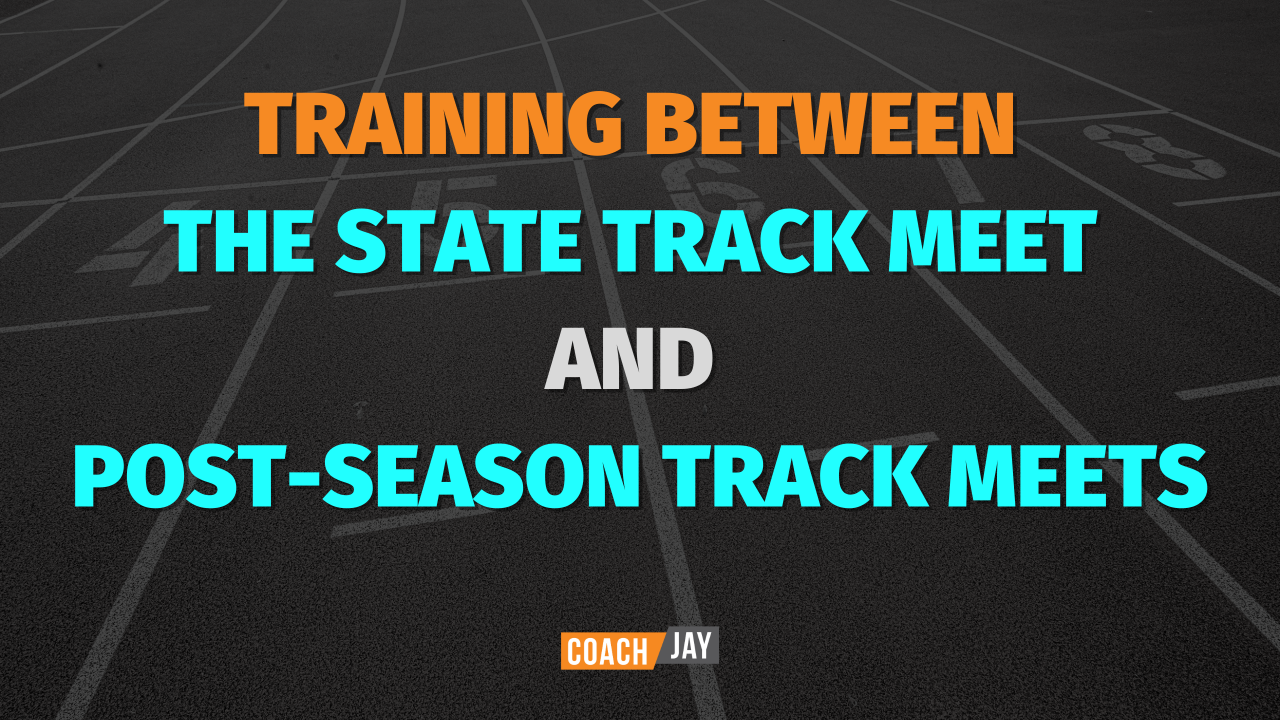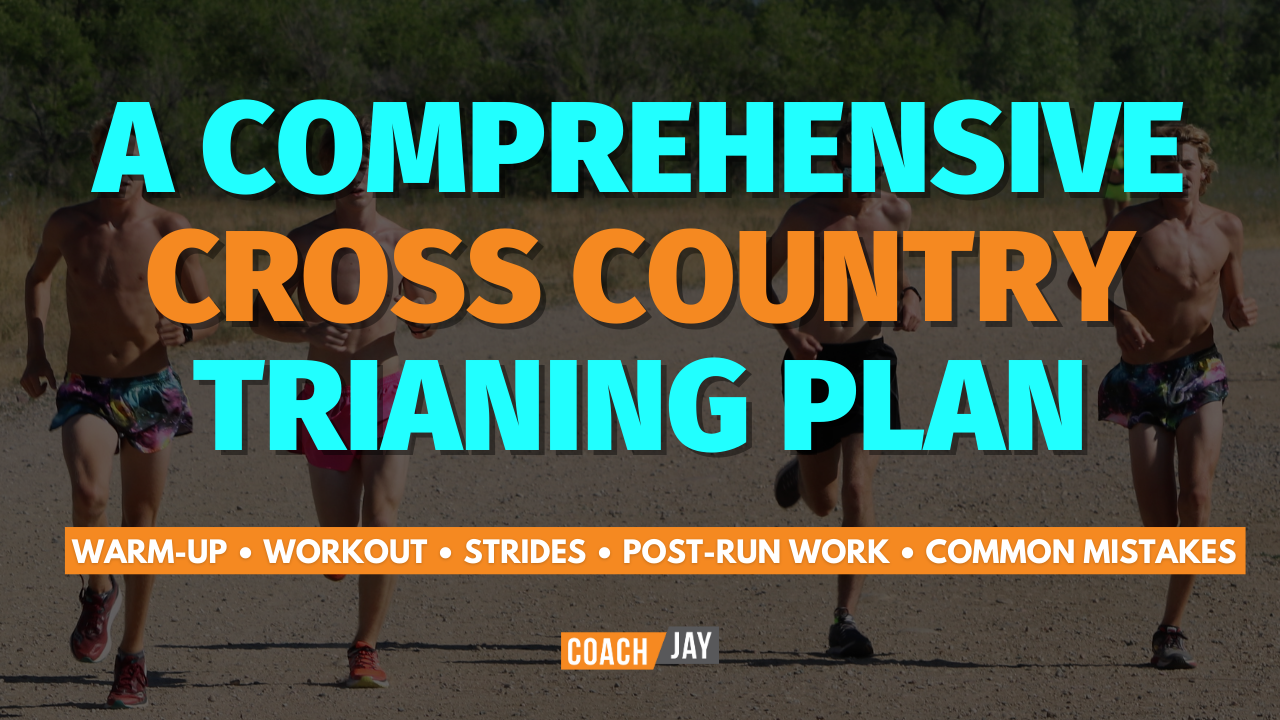
Training Between The State Track Meet and Post-Season Track Meets
For this runner to run a PR at a post-season national meet – be it the New Balance Outdoor Nationals or the Nike Outdoor Nationals – they must be mentally and physically recovered from the state meet.
A common problem – and one we can easily fix – is to make sure the athletes take a few easy days following the state track meet. Physically, they can handle decent training loads the week after state. But there is an emotional letdown after the state track meet, and that's the piece we need to acknowledge. Couple that letdown with the end-of-the-year banquets and possibly graduation, and you have a busy student-athlete who needs to be fully recharged before we start training hard.
Yet once the athlete is fired up to train, you, the coach, need to let them train hard and use intelligent workouts to advance their fitness.
Aerobic Workout vs. Race Pace Workouts
Quickly: How many races or race pace workouts has the runner done in the past 4-5 weeks? A lot.
How many challenging aerobic workouts have they done? Not as many as they did in February and March.
Depending on how many weeks the runner has until the post-season meet, we want to try to advance their aerobic fitness. Do we need to do some race-pace workouts at goal PR pace? Absolutely. But we don't need two or three or four weeks of race pace workouts for them to be ready for them to PR.
The following training will have them get in more aerobic workouts the first week back. From there, we'll decide what workouts are best based on how much time we have.
Training For Post-Season Track Meets
Here's what the first week after the state meet should look like.
Saturday – State meet
Sunday – Easy run – the shortest they can imagine, then some mobility work, which will help them determine what's sore and identify any possible "niggles." If something feels off, they can make an appointment with a physical therapist, chiropractor, or sports massage therapist first thing Monday morning.
Monday – Day off from running and probably a day of complete rest. If they must do something, try pool walking for 15 minutes, followed by some mobility work and light self-massage. Or a brisk walk for 20 minutes.
Tuesday – Very easy run and easy strides. No need to spike up. Very light post-run work. The athlete can do this on their own. This means the coach could take Monday and Tuesday off for a mini break.
Wednesday – Some coaches would say this is the day to resume training, but I think it's best to have one more easy day. Why? Let's have them excited to train tomorrow and eager to work hard. The post-run work should be light. The coach doesn't need to meet the athlete on this day, either.
Thursday – Throughout the year, you've done challenging aerobic workouts: long runs, fartlek runs, progression runs, and threshold runs. Today we want to do a "moderately challenging" workout. Consider a short progression run that starts very conservatively.
Many athletes coached by coaches in the Track Training System would have done a 30-minute progression run of 10 minutes steady, 10 minutes a bit fast, 5 minutes a bit faster, 5 minutes fast but controlled. You can shorten this to 10-5-5-5 for a 25-minute run, plus tell them to run the first 10-minute segment at a very easy pace.
The bottom line on this day is that: (a) we're doing an aerobic workout and not a race pace workout, and (b) we're not hitting it hard.
Friday – Easy and strides, with normal post-run work. This is a day the coach does not need to meet the athlete.
Saturday – Most people would do a long run here. If you want to do that, be mindful of the volume. Six days ago, your athlete either ran a prelim or possibly a final at the state meet. While they're recovered from that by now, there is no reason to make this one of the best long runs of their high school career. I like the idea of an hour run that gets progressively faster. You could do more, but I'm not sure you need to.
All the coaches I work with in the Track Training System have athletes make strides in the last 20 minutes of their long run, yet if you haven't done that, you don't want to do that here. Check out this article on challenging aerobic workouts to learn why strides during a long run is a great idea.
Here's a 60-minute progression run that's fun and will advance their fitness.
- 20 minutes at their normal easy run pace
- 10 minutes a touch faster
- 10 minutes at a pace that's slower than their threshold run pace
- 10 minutes a touch faster – they don't time this; they just run by feel
- 5 minutes at a fun, fast pace – this is fast and fun but controlled
- 5 minutes easy, then right into their post-run work
They'll have fun with this workout, they'll get a great aerobic stimulus, and they'll be fully recovered by Monday to do whatever training you want to use.
Be sure to tell your athlete that the last 5 minutes are controlled. Let them know: "I want you to finish knowing you had 5 more minutes at that pace, no problem. And if you had to, you could have run 10 more minutes at that pace, but that would have felt like a hard road race." Make sure they understand that they don't need a killer stimulus today to gain fitness.
Sunday – This is a great day for a 20-30 min brisk walk, an easy 30-45 min bike ride, or simply playing at the pool with friends. Even if they typically run 7 days a week, this may be a good day to take off.
Race Pace Workouts at Goal Pace – "Fast, Faster, Fastest"
Before we talk about what training your runners should do to PR at the post-season track meet, let's make sure we understand the goal of the race-pace workouts.
You need your athletes to groove PR pace they want to run. And if they're running any distance over 800m, you need to empower them with the ability to switch gears and cover moves.
Do those two things, and they'll be ready to run a PR.
I like having athletes do either workout they've done before or a workout they've done before but with slightly less volume (maybe one less rep).
You want to make sure they leave the track after these workouts confident they can run a PR. And the best way to do that is to (a) have them run splits they've never run before; and (b) have them feel decent, and perhaps comfortable, running those splits.
This isn't the article to discuss workouts, but again, it's smart to do workouts they've done before as they don't have to think about how to execute it– they just try to run it faster than they've run before.
How Many Weeks Until The Post-Season Meet Do You Have?
Now the question is, how many weeks do you have remaining until the post-season meet?
If you have only one more week, you can get in one hard race pace workout and possibly one light workout (we use a 48-hour workout in the Track Training System and then a pre-race day prior to a race).
If you have two more weeks, you could do one hard race-pace workout and one or two challenging aerobic workouts. Again, I'm not sure you need a long run this week, but if the athlete wants to do one, then do one. The key here is not to have the best week of training of the year – just a solid week of training where they're excited to train each day. A great workout for this week is the 30-90 fartlek – read about it in this article.
In the final week of a two-week period you can do what I outlined above.
If you have three more weeks, there is a lot to be said for a week with no race-pace workouts but days where they spike up several times for fast strides. This is a week where a long run makes sense. I also like the idea of a progression run that's shorter, then coming back to the track for some fast 150s or even 200s. You could do 4 x 150m or 3 x 200m. These should be fast, but allow plenty of rest.
Kelly Christensen, at Niwot High School, often does 200s after threshold runs – thanks to Kelly for sharing this!
When you have more time, it's crucial for your athlete to stay mentally engaged and fired up to train.
There is also something to be said for a killer workout or two on the track or a time trial. I really like time trials when you have this much time.
- 800m runner does a 600m time trial
- 1600m runner does a 1000m or 1200m time trial
- 3200m runner does a 2000m time trial
The key with all of these is that you have them do 100m strides at the pace you want them to go out at, as they should be running this distance MUCH faster than their race pace.
And you can replicate what they'll have to do at the meet. If they're racing at 7 or 8 pm, have them run at that time of day. Have them do a pre-race day the day before. Make a big deal of this and see what they can run. Also, this is helpful for you with future athletes as you'll have the data from this workout, which may provide a predictive quality for what an athlete can run at nationals.
Taking A Break Between Track and Summer Cross Country Training
You should be asking yourself: "How much time off should I give them after the track season before cross country season?"
I like one easy week with minimal activity and then a second week where they run three days. Some coaches want to start right away; others want two weeks of no training. My approach is a balance between the two. The key: athletes need to be bored and chomping at the bit before they resume training.
I outline that clearly in this article: Two Week Break Between Track and Cross Country.
Summer Cross Country Training
The XC Training Essentials course is free and has five-week training plans for all levels of athletes. There are also 12 weeks of middle school training for free. There are several hours of concise videos and dozens of PDFs for you to download.















